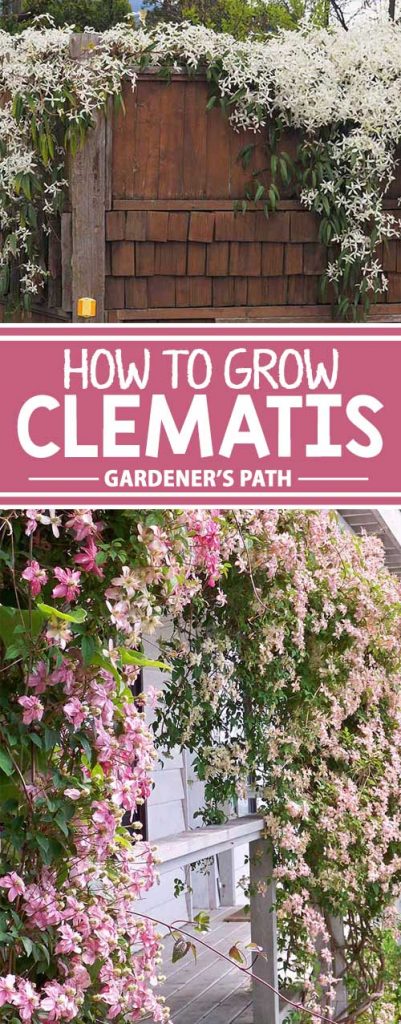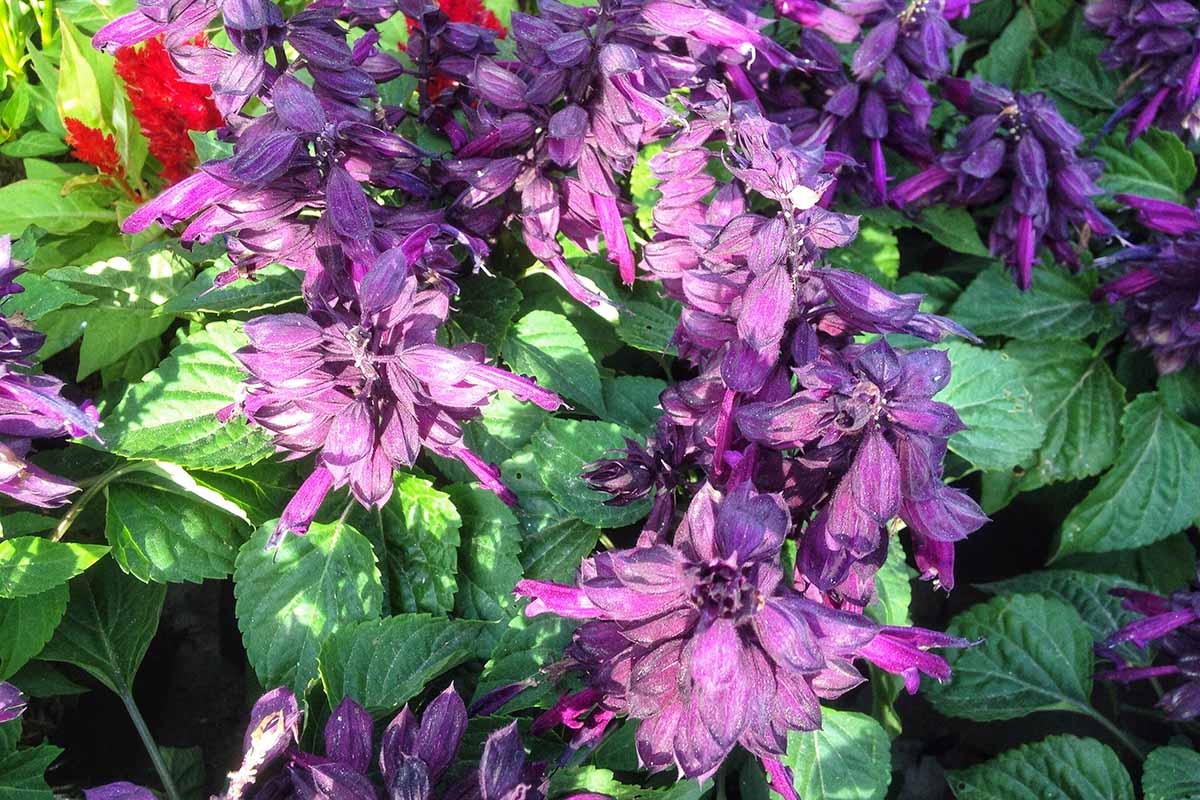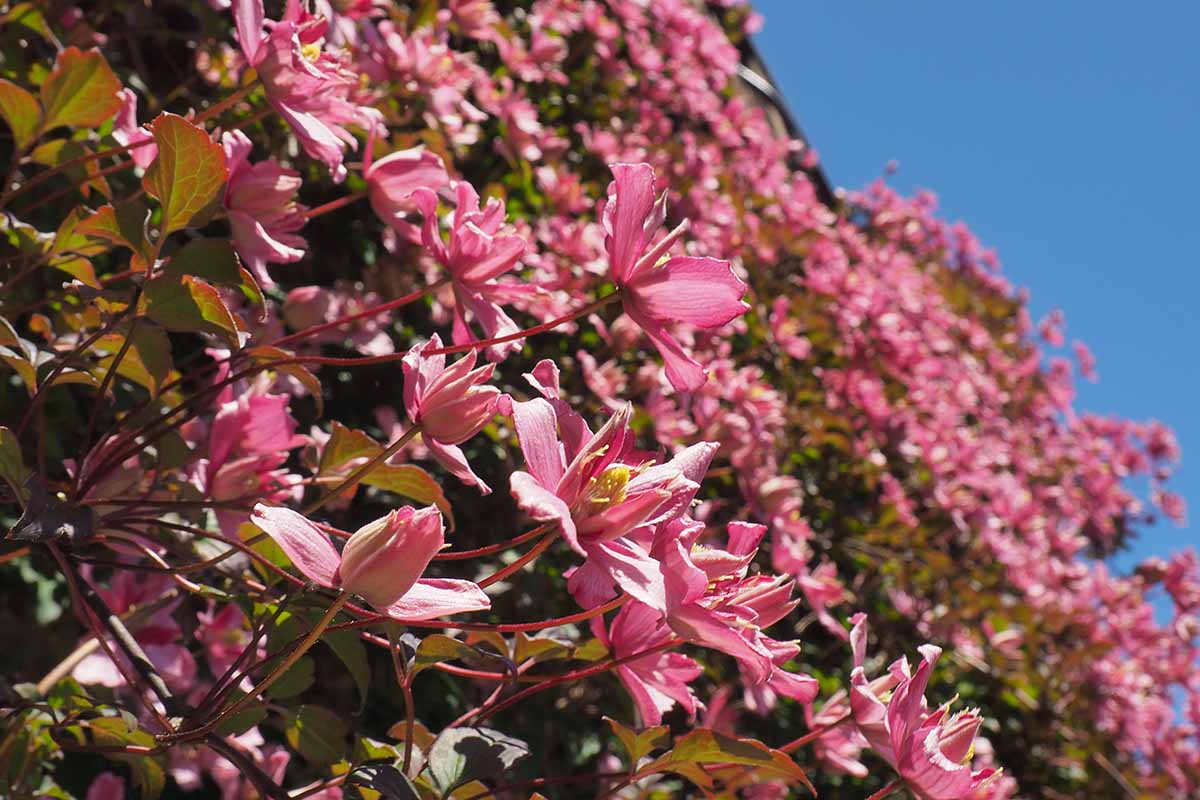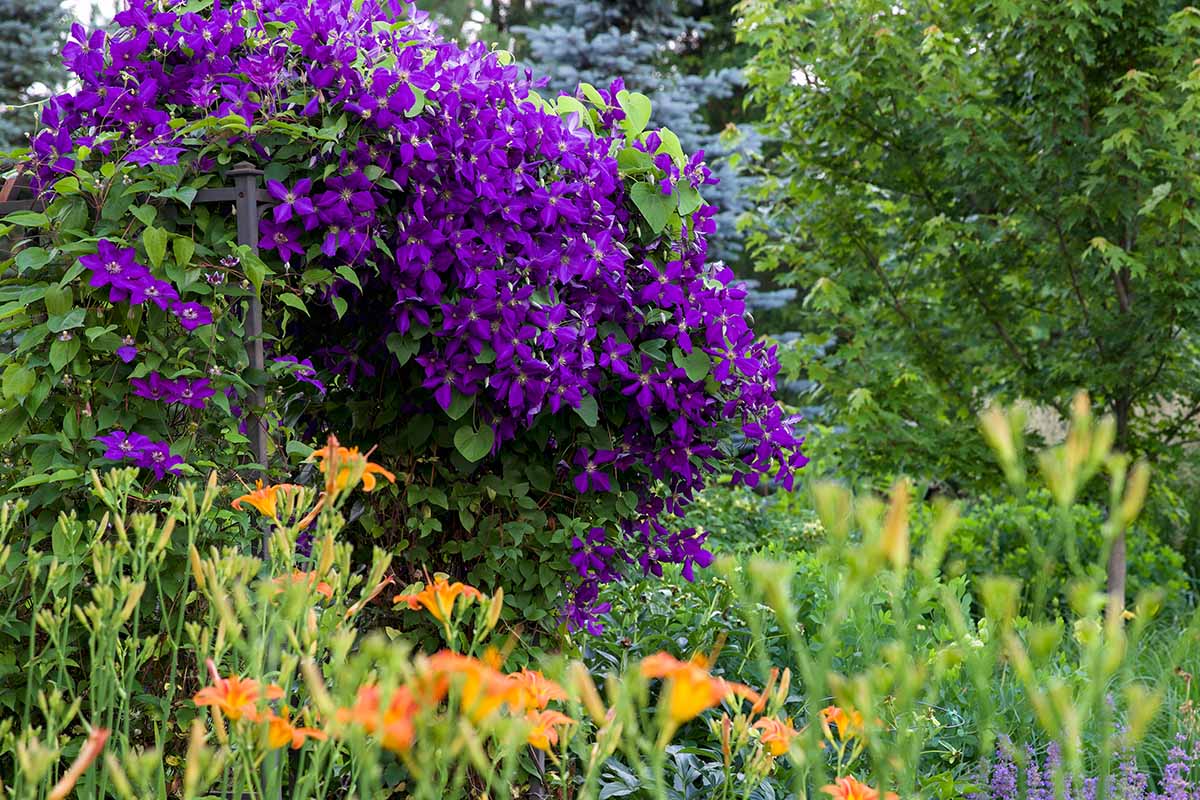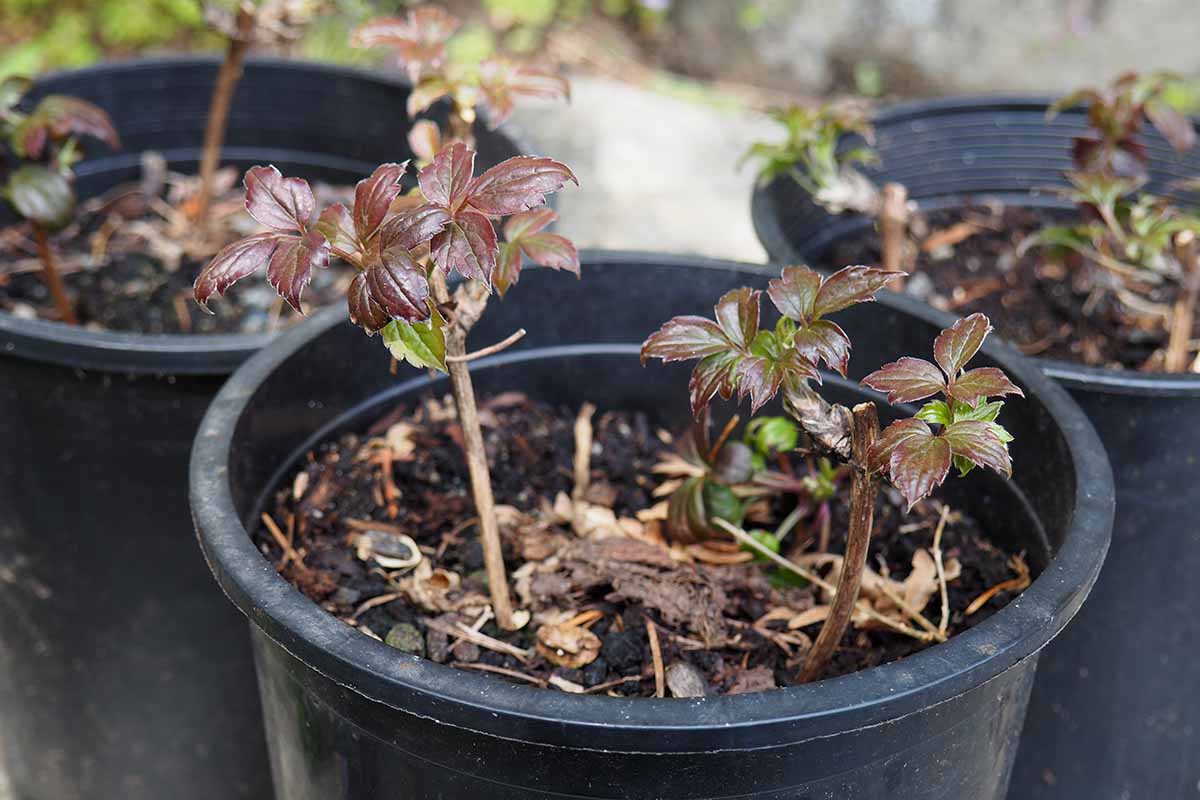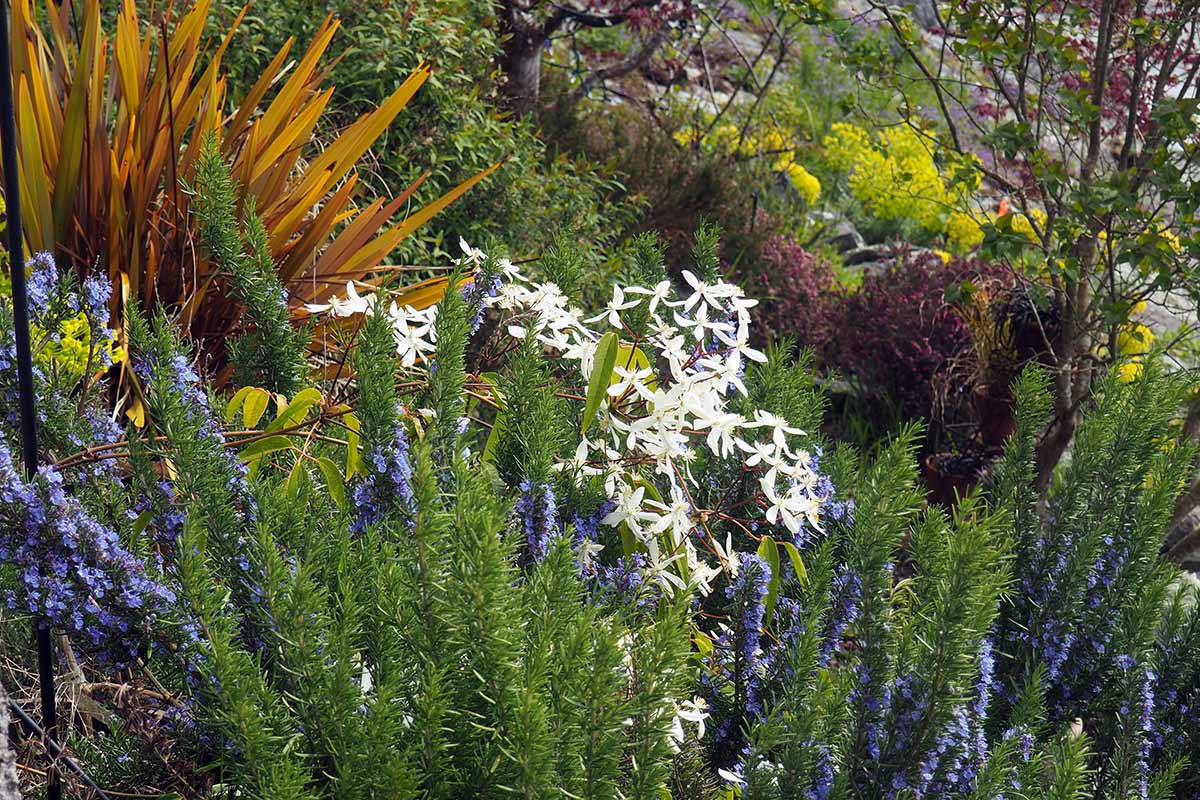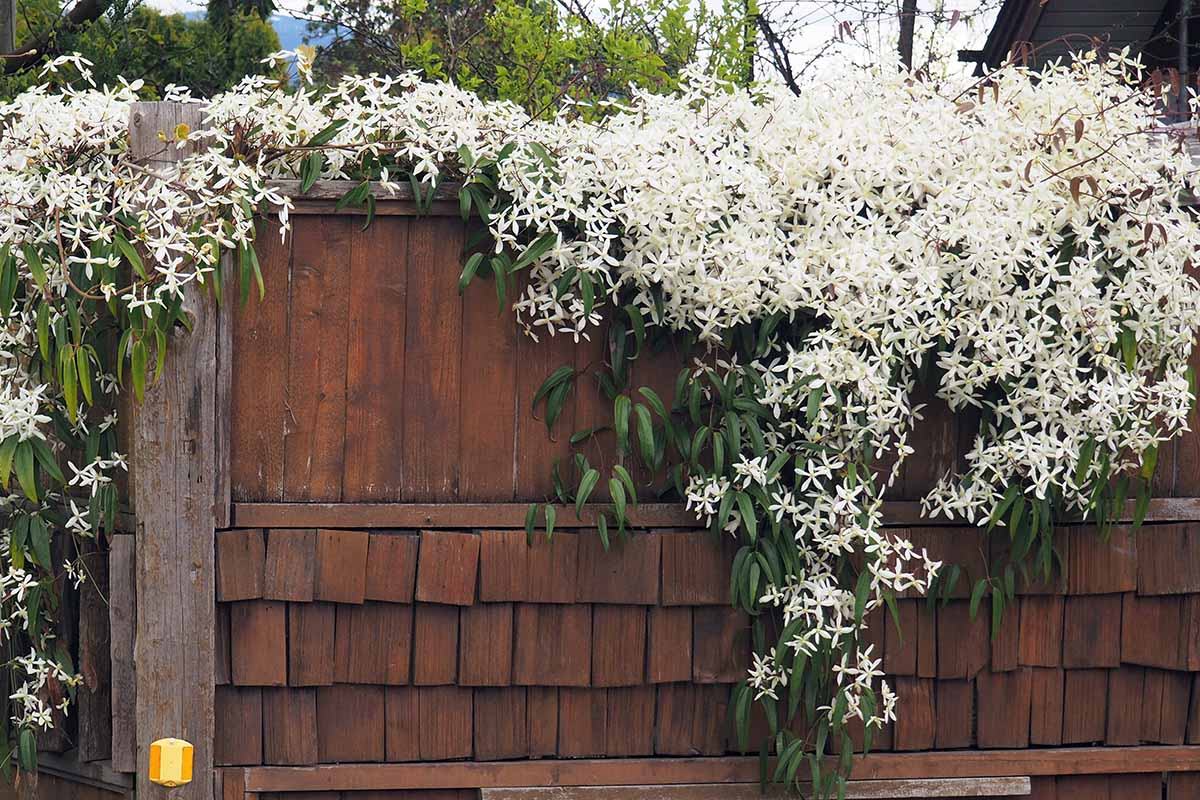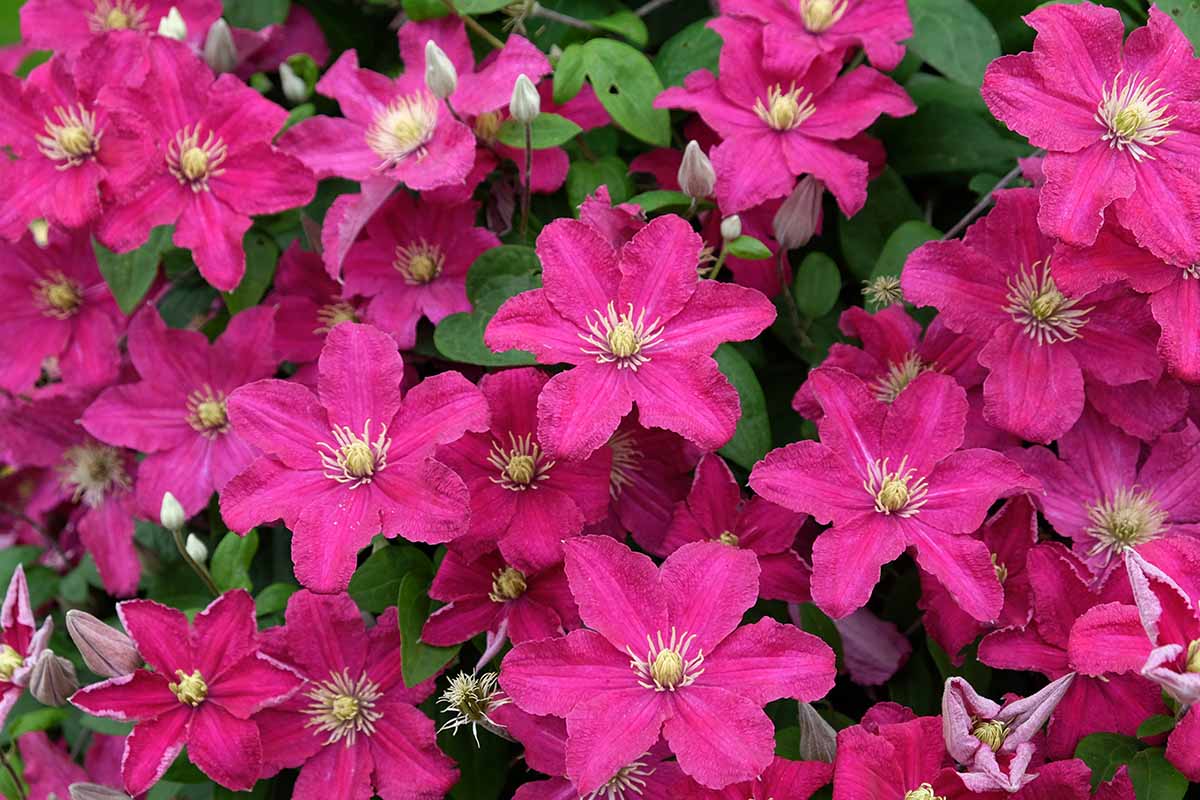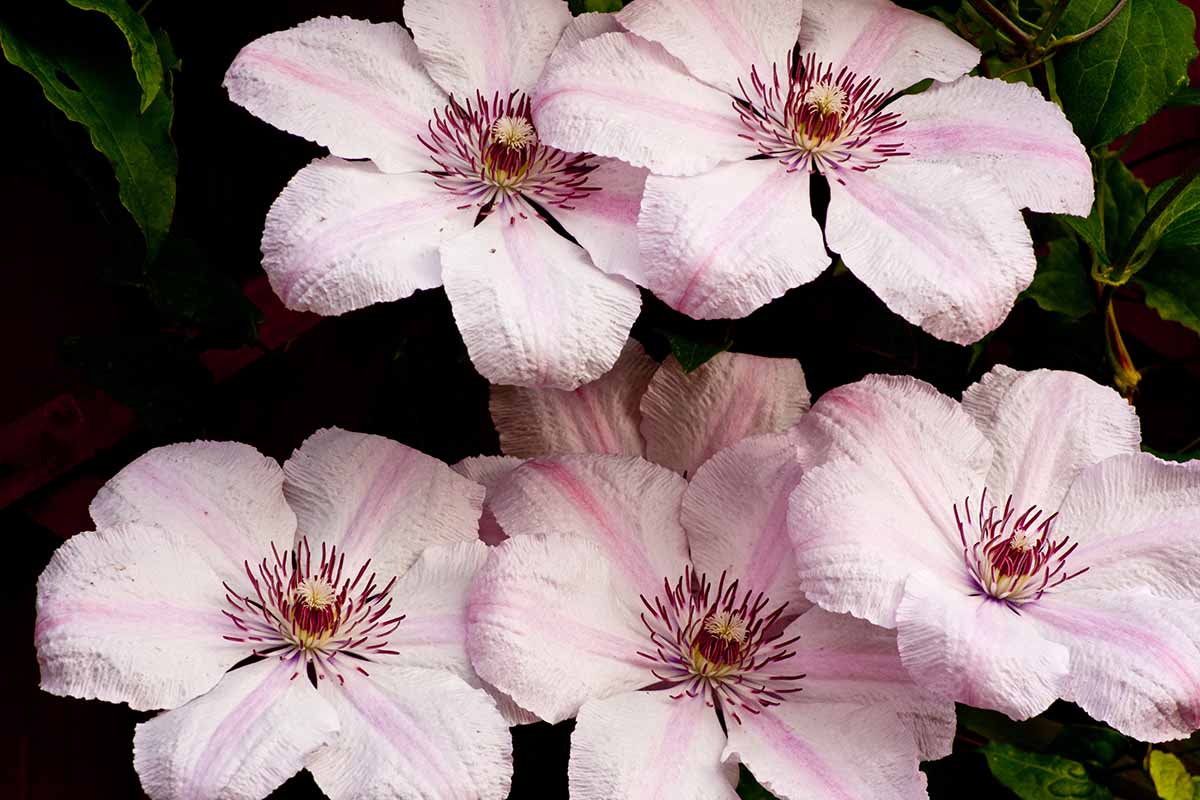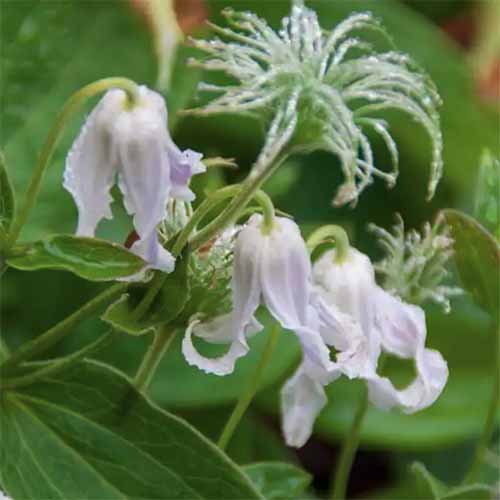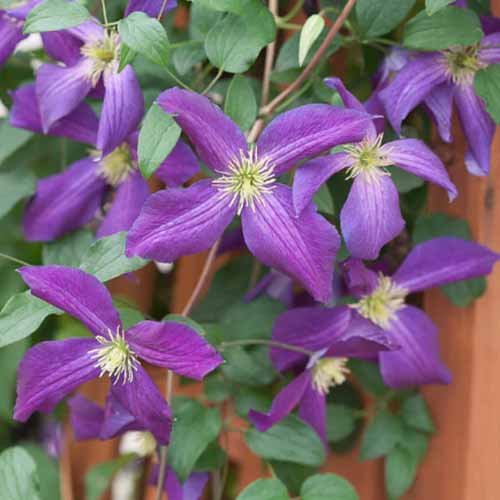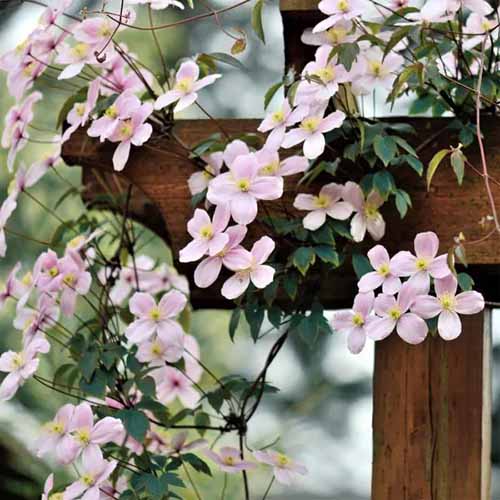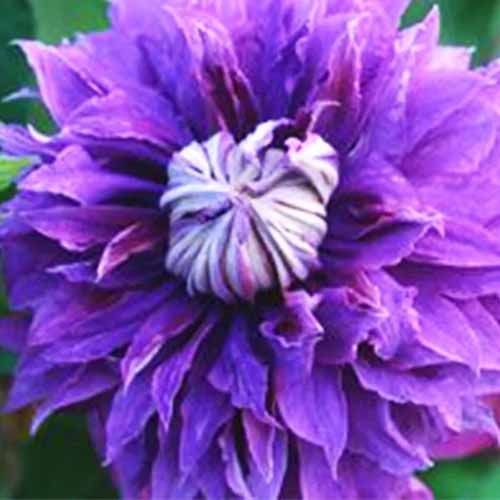With stunning diversity, these hardy vines put on an unforgettable show that includes color, fragrance, and multiseason displays of both flowers and showy seed heads. We link to vendors to help you find relevant products. If you buy from one of our links, we may earn a commission. Some are evergreen, some deciduous. Flower sizes range from small and delicate to large plate-sized blossoms, and some even fill the air with sweet perfume. And they come in a great variety of sizes suitable for a myriad of settings that includes borders, containers, ground covers, screens, and trellises. But, they do have a reputation for being a bit difficult to grow – with confusion over pruning being the main reason. Despite rumors to the contrary, clematis vines are vigorous, reliable ornamentals and they are simple to cultivate with little effort. It’s true that they’re finicky about where they like to set their roots. And yes, a bit of extra attention when planting will make a big difference in their ongoing performance. But once established, the brilliant yearly masses of climbing, tumbling flowers will make you forget all about that little bit of extra initial effort. Even pruning clematis is easy – it’s true! Once you know our easy-to-remember pruning tip, that is… keep reading for that. If easy-care vines covered in flowers sound like something your garden needs, then let’s dig into the complete clematis growing guide! Here’s everything we’ll cover:
What Is Clematis?
Clematis is a genus of perennial flowering vines in the Ranunculaceae or buttercup family. Numbers vary, but there are an estimated 300 to 400 known species native to Asia, Europe, Oceania, and North America with thousands of available cultivars. Most are climbers, with fast-growing, woody vines that scale, sprawl, and tumble over anything in their path. But there are also a few erect (i.e. non-climbing), herbaceous shrub types such as C. recta, and several that make excellent ground covers, like C. praecox. Flower colors include blue, gold, lavender, pink, purple, red, yellow, and white. Flower size and orientation also varies, ranging from small, nodding bells to massive, open-faced pinwheels. Many also feature prominent, showy seed heads in autumn with swirling, silken threads that last into winter, giving multiple seasons of interest. And in early spring, hummingbirds often collect the remaining silky threads for nesting material. Some flowers feature a sweet, vanilla-like fragrance such as the early-flowering C. armandii and C. montana and the late-flowering C. terniflora. However, most of the summer-flowering group are without scent, with a few exceptions – ‘Fragrant Star,’ ‘Pacific Cup,’ and ‘Sweet Summer Love’ are noted for their sweet perfume. Mature sizes also vary considerably. The small, herbaceous types grow only a few feet and many of the showy summer varieties are in the range of eight to 15 feet. But there are also the sprawling early varieties that can stretch out an impressive 20 to 40 feet. Depending on the species, growth is either deciduous or evergreen. Most species are native to temperate regions, with deciduous vines hailing from colder climates and the less-hardy evergreens being indigenous to warmer regions. However, there is one tropical species – C. smilacifolia is a fragrant evergreen native to India that does well in hot, humid climates. For the home gardener, plants are divided into three groups, and each group has a different flowering time and different pruning requirements. Group 1 are the early flowering vines that bloom in late winter and spring. Group 2 are the reblooming summer varieties. And Group 3 flower in summer and fall. The vines feature opposing leaves that range from long, narrow, and glossy with a thick, leathery texture on the evergreens, to divided and lightly toothed foliage on the deciduous vines. Unlike other ornamental vines, clematis are non-clinging and don’t damage building exteriors. Instead, they climb using leaf tendrils to twist around supporting structures such as trellises or other plants. Plant hardiness varies extensively, but generally falls in the range of USDA Zones 3 to 9 – although there are a few selections that extend into cooler zones and several for warmer regions.
Cultivation and History
Clematis has rightfully earned the moniker Queen of the Vines for its spectacular climbing performance and is aptly named from the ancient Greek word “klema,” which loosely means climbing vine. One of the first imported species to the UK, C. viticella was cultivated as early as 1549 by avid botanist Hugh Morgan, Apothecary to Queen Elizabeth I. And cultivation of the Chinese species C. florida was underway in Japan in the early 17th century, where its image was widely used in calligraphy and lacquer work, and on clothes. The introduction of Japanese species like C. patens in the 1830s was a boon for European breeders that is still reflected in many of today’s popular, large-flowered cultivars, like the timeless ‘Jackmanii.’ Introduced in 1863, it was one of the first large-flowered hybrids available to the public. Although several species are native to North America, the severe winters in many areas posed a challenge for breeders. Thanks to their persistence, there are now several handsome options suitable for gardeners who experience cold winters in Zone 3 – and even Zone 2. If you live in those areas, be sure to check our guide to 27 of the best cold hardy clematis varieties for recommendations.
Propagation
Clematis can be grown from seed, but germination can take up to three years! Propagation via stem cuttings is a much faster method for the home gardener. Cuttings are taken from vines with no flowers or flower buds in spring using softwood stems, or in summer from semi-ripe wood. If propagating in spring, allow new growth to mature for a few weeks before cutting. This helps to toughen the green softwood a bit so it can survive the handling and shock. Also, avoid using tender growing tips because they’re too fragile to undergo the rooting process. Choose a long section of healthy vine with several sets of leaves to create multiple cuttings. Using clean, sterile scissors or snips, cut half an inch to an inch above a leaf joint – this is the bottom cut. Make the top cut one inch above the next healthy leaves. Continue cutting sections until you reach the last set of leaves before the stem tip. Discard the tip. Each section will have a piece of stem three to four inches long with a set of leaves at the top. Dip the bottom end into rooting hormone powder and shake gently to remove any excess dust. Insert three to four prepared stems into a four- to six-inch pot filled with moist starter soil. Gently firm the soil around the stems. In areas with dry air, cover the pots with a plastic bag to retain moisture. Use chopsticks inserted into the soil to keep the bag from touching the cuttings and secure the bag around the pot with an elastic band. Place in bright, indirect light and keep the soil moist. Roots should form in four to eight weeks. Once rooted, remove the plastic cover. After plants are fully rooted and producing ample new growth, cut stems back to 12 inches to encourage branching. Transplant into their permanent location in late summer.
How to Grow
Clematis can be planted in spring, summer, or fall. If planted in spring or summer, it’s best to occasionally pinch out growing tips over the first growing season. They like a cool, deep, and moist root run, and a little extra time and care invested into creating the ideal planting site ensures the best possible performance. The vines prefer loose, loamy soil with excellent drainage and a mildly acidic to neutral pH of 6.0 to 7.5, in a full sun location. Before planting, soak the root ball (in its nursery pot) in a bucket of water for 15 minutes or so. Create a large planting hole that’s 18 to 24 inches wide and deep. Loosen and remove the soil, then enrich by mixing in two or three shovelfuls of organic material such as aged compost or mature manure. Add in a shovelful or two of moisture-retentive material such as coconut coir, peat moss, perlite, or vermiculite to help keep roots cool and moist. If you need to improve drainage, add one to three shovelfuls of landscape sand or pea gravel. Be generous with the gravel or sand if your site tends to become soggy – the roots cannot abide wet conditions or standing water. Mix the ingredients well until the soil is light, loose, and friable. Return about three-quarters of the amended soil to the planting hole, then mix in some bone meal for healthy root growth. This is the time to set your trellis or other supports in place. Doing so before the vines are planted helps to prevent accidental damage. Water the soil in the planting hole thoroughly. Most commercial specimens are purchased with the vines attached to a small stake, with the stake stapled to the plastic pot. Carefully remove the staples, but keep the stake attached to the vines. Gently remove the root ball from the nursery pot and set it in the planting hole. Evergreen varieties are planted with the crown level to the soil surface. For deciduous varieties, plant the root ball so that the crown is four to six inches below the surface, setting it on a 45-degree angle with the vines and nursery stake leaning toward their trellis or other permanent support. Planting the crown deeply encourages new stems to grow from the underground leaf axis and also provides winter protection. Refill the planting hole with the amended soil and gently firm in place. Attach the vines to their trellis with plant clips, twine, or garden velcro. Water thoroughly. Plants require a minimum of one gallon of water per week, and this quantity should be increased in hot weather. They also enjoy plenty of sunlight and prefer a location where they’ll receive a minimum of six hours per day. However, for dark-blossomed specimens, like the deep purple C. romantika or C. x jackmanii, a spot with dappled or light afternoon shade in the hot summer months helps to retain flower color and prevent fading. Now, having said that they like a sunny location, clematis also like to have cool roots – “head in the sun and roots in the shade” is the popular saying. If needed, create some shade for the root zone by planting a small shrub or shallow-rooted ground cover in front of the vines. Many varieties are also suitable for container care. Provide the same soil mix and growing conditions as for those planted in the ground, with well-draining soil, cool roots, and vines growing in the sun. Our guide on how to grow clematis in containers has all the details for successful potted vines.
Growing Tips
Use the following tips to encourage flower-laden stems.
Ensure the trellis slats are small enough for leaf tendrils to wrap around – 3/4 inch max.Help initial growth find support by gently attaching vines with plant clips, twine, or velcro.Provide shade for the roots with shallow-rooted ground covers or shrubs.
Maintenance
A little regular maintenance also helps to develop strong, healthy plants. Starting in mid-spring and continuing to midsummer, fertilize plants monthly using a balanced 10-10-10 (NPK) fertilizer. During their first growing season, all clematis benefit substantially if the tips of new shoots are pinched out regularly to encourage branching. In the first spring after planting, just after new growth emerges, cut back the vines to promote branching, new stems, and bushier plants. Prune hard as for Group 3 (more on groupings in a little bit), or to the strongest set of buds approximately 12 inches above the crown. After the hard pruning in the first spring, follow the pruning guide below. For winter care, add a thick mulch to protect the crown from freezing and thaw cycles. For more suggestions on how to protect your vines in cold temperatures, our guide to clematis winter care has the details.
Pruning
Clematis are divided into three different groups according to their flowering time and unique pruning regime. They’re referred to as Groups 1, 2, and 3 or sometimes as Groups A, B, and C. Trying to remember the details for each classification can be a bit confusing, so here’s our simple tip to make this important task easier: the earlier they bloom, the less pruning they require. Keep this in mind as we outline the requirements for each group. And if you’d like more details, read our guide on how to prune clematis vines for copious flowers.
Group 1
Group 1 are the early bloomers that flower from late winter to mid-spring, such as the fragrant evergreen C. armandii and the early spring showstopper, C. montana. Remembering our tip, this first group requires no pruning for flowers to develop because they form entirely on old wood. As such, they need only a light grooming to tidy plants. Any pruning should be performed immediately after flowering and requires only a light touch. Cut back just to remove dead wood, to thin tangled growth, or to shape vines. Find a suggested selection of Group 1 cultivars in our guide to 13 of the best spring-flowering clematis varieties.
Group 2
Group 2 vines are the large-flowered cultivars that flower in late spring and early summer on old wood. Then, they produce a second, lighter flush of flowers in late summer on new wood. Examples of popular Group 2 specimens include ‘Nelly Moser’ and ‘Jackmanii,’ the latter often referred to as C. x jackmanii Referring to our tip, this midseason group requires a moderate amount of selective pruning. In early spring just as new leaf buds emerge, trim away any dead, damaged, or weak stems. At this time, avoid heavy pruning or significant size reduction to prevent flower loss. Then, immediately after the first set of flowers has finished in early summer, a second, harder pruning is called for. Cut back stems to a healthy side shoot or strong set of buds, just below the spent blossoms. This encourages branching and a second flush of flowers on new growth. If your Group 2 vines need to be reshaped or reduced in size, this is when to do it. But don’t go crazy – old wood is still needed for next year’s first flush of flowers. To retain as many blossoms as possible, reshape gradually over the course of two to three years. For vine selection in Group 2, check out our guide to 19 of the best summer-flowering clematis types.
Group 3
Group 3 are the late cultivars that flower from summer through autumn. These late-bloomers, such as ‘Princess Diana’ and ‘Ville de Lyon,’ require the most extensive pruning – but it’s a very easy task. In late winter or early spring, simply cut back all vines to a set of strong, healthy buds anywhere from eight to 16 inches above the ground. All of the previous year’s growth is removed, and flowers develop entirely on new wood. For group 3 selections, check out our guide to 17 of the best fall-blooming clematis varieties. Clematis is a plant that’s naturally robust and easy to grow, but there are a few issues to watch out for.
Hakuree
Compact and bushy, the low-growing C. integrifolia ‘Hakuree’ has masses of pendulous, bell-shaped flowers with charming twisted “petals” (actually sepals) in the early summer to early fall garden. The white flowers have a sweet vanilla scent and take on blue tones in cool temperatures. Flowers are followed by swirling, silky seed heads through fall and winter and the ovate foliage is dark green. ‘Hakuree’ A non-climber, these plants lean instead of clinging and work well in containers, as a ground cover, staked upright in borders, or wending through shrubs. They grow 24 to 28 inches tall and belong to Group 3. And they’re hardy in Zones 4 to 9. Bare root plants are available at Home Depot.
Happy Jack
For an abundance of gorgeous, velvety flowers in deep purple with platinum anthers, ‘Happy Jack’ (aka ‘Zojapur’) flowers heavily in midsummer, then produces repeat blooms in late summer and fall after deadheading. A hybrid with C. x jackmanii parentage, flowers hold their color in strong sun. ‘Happy Jack’ A perfect choice to make a strong impact in containers, as a privacy screen, climbing upright on trellises, and in butterfly gardens, these carefree vines grow six to 10 feet long and belong to Group 2. They’re hardy in Zones 5 to 9. Plants in nursery containers are available from Planting Tree.
Helios
A beautiful, mid-sized vine for the summer garden, C. tangutica ‘Helios’ features nodding, lantern-shaped flowers with a sweet scent of coconut. Blooming from June to October, the sunshine-yellow petals open as they mature, revealing contrasting dark purple anthers. After flowering, whimsical silky seed heads mix in with the flowers and dark green foliage. ‘Helios’ Vines grow to a height of six to eight feet and this variety makes an excellent container plant, screen, or specimen in courtyard and patio beds. ‘Helios’ belongs to Group 3 and the vines are hardy in Zones 4 to 9. Container plants are available at Walmart.
Mayleen
A RHS Award of Garden Merit winner, C. montana var. rubens ‘Mayleen’ produces masses of rounded flowers in satin pink with pretty yellow stamens. Flowering in late spring and early summer, it’s among the most fragrant of all clematis varieties and emits a rich vanilla perfume. The small, divided leaves emerge with a burnished bronze hue before maturing to dark green. ‘Mayleen’ A vigorous climber that reaches 20 to 30 feet in about five years, the vines need a sturdy trellis for vertical displays. Also outstanding as a screen or coverup when roaming over scrubby areas, stumps, and walls, ‘Mayleen’ belongs to Group 1 and is hardy in Zones 6 to 9. Plants in nursery containers are available at Nature Hills Nursery.
Regal Diamantina
For double and single-flowered beauty, check out the unique floral display of ‘Regal Diamantina,’ aka ‘Evipo039.’ Brilliant lilac-blue flowers with pink highlights first appear as plump, double-petaled pom-poms in early summer, with a rebloom of single flowers in late summer after deadheading. ‘Regal Diamantina’ The tidy vines have a mature height of six to eight feet and make an excellent addition to containers, or as a vertical screen or specimen in smaller spaces like courtyards or patio beds. These plants belong to Group 2 and are hardy in Zones 4 to 9. Vines in nursery containers are available at Nature Hills Nursery.
Managing Pests and Disease
With their roots in the shade, slugs and snails are attracted to tender new shoots. Prevent access to green stems with a barrier of crushed eggshells or diatomaceous earth – or use some of the other methods described in our guide on how to protect your garden from slugs and snails. Clematis wilt usually targets the large-flowered, midseason varieties and is characterized by a rapid decline in health, with leaves and stalks turning black before dying. Remove and destroy any damaged shoots, avoid overhead watering, and treat with a commercial fungus-fighter if needed. Bonide Sulfur Plant Fungicide can be used as a preventative measure. It’s available at Arbico Organics. Bonide Sulfur Plant Fungicide Clematis slime flux appears as a smelly, white ooze emanating from the stems in spring. Since this is a bacterial infection that occurs on damaged stems, protection against damage is the best prevention. Cut the affected stem back below the ooze, and new shoots may develop in the same growing season. Cut back infected stems to healthy growth and provide mulch to keep roots cool. Ensure that your vines are growing in the sun or choose small-flowered species that are resistant to wilt such as C. alpina, C. montana, and C. macropetala.
Best Uses
With their wide range of sizes, clematis are suitable for a host of settings. Small bushy varieties such as C. integrifolia make an excellent addition to borders, beds, and containers. They’re also fantastic in rock gardens. Midsized cultivars, like the many summer-flowering ones, are superb on trellises and highly effective in containers, as screens or specimens, or scrambling through shrubs in smaller settings like patio, city, and courtyard beds. Large varieties, like C. armandii and C. montana, are superb vertical specimens when grown upright on trellises. And they also make unique ground covers to ramble over rocks, stumps, and walls, or as a coverup for unsightly problem areas like ramshackle tool sheds. Spend a bit of time preparing the planting site, set up a trellis right away, provide plenty of sunshine, keep the roots cool, and cut vines back in their first year. And of course, remember our tip – the earlier they bloom, the less you need to prune. Give them what they want and they’ll perform like champions with an exuberant display of showy flowers each year! How do you folks use clematis in the garden? Let us know in the comments section below. And if clematis flowers are your thing, you can read more about their care and cultivation in some of our other guides, starting with these:
How to Train Clematis to Grow Vertically Up Poles or TreesTypes of Clematis and How to Identify Your Vines9 Reasons for Yellow Clematis Leaves

